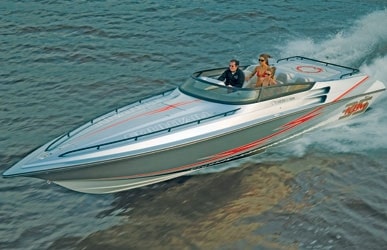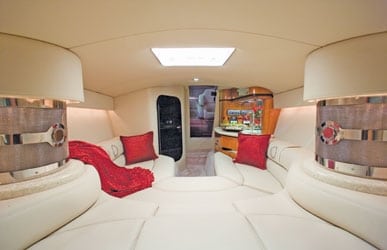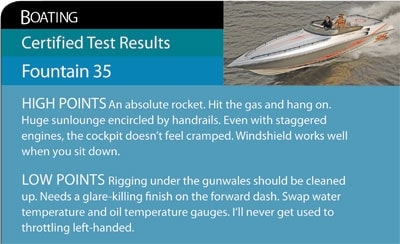
Fountain 35

Fountain 35

Fountain 35

Fountain 35
After taking a little while to get to know the Fountain 35 Lightning/ICBM, I ran it up to 106.1 mph at 5200 rpm. I felt quite comfortable at those speeds, but it wasn’t until I returned to the docks that I realized why. Fountain Powerboats put a raised throttle box on the dash, which places the levers closer to the driver. That’s important when you’re working the sticks in rough water.
Anyone with some go-fast performance could run this boat right up to 90 mph. The boat feels solid and stable. When you’re looking to top the century mark, you need to know what you’re doing. Remember, this boat has a built-in 2′-long swim platform as well as a 1′ to 2′ bow extension, so you’re actually running those 1,000 ponies in a 31′ boat. The key word to getting the most out of the 35′ Lightning/ICBM is subtlety. Barely turning the wheel corrects your course. Just a tap on the trim buttons makes a big difference.
To get the boat on plane quickly, the bottom features a unique mini-strake close to the V on each side of the bow. Once you’re running 50 mph, slam the throttles – you hit 70 in 8.4 seconds. Do the same at 60 mph and you’ll hit 80 in 9.2 seconds.
Put the 35 Lightning/ICBM into turns and the boat handles smoothly, acing slalom passes right up to 60 mph. In circles, it carved arcs at 70 with no problem. I made evasive maneuvers at 80 mph plus and maintained total control.
Like all new Fountain sportboats, the 35 Lightning/ICBM has staggered engines, which put the drives about 1’4″ closer together than they’d be in a boat with side-by-side engines. That positioning reduces hydrodynamic drag. The boat was also equipped with SportMaster 2″ shorter-than-stock lower units on the Bravo XR drives and Hering propellers, which are good for at least 2 mph on their own.
For competitors, check out Donzi’s 35 ZR, which hit 93.2 mph in my test in the inaugural issue of SpeedBoat (January 2005) and retails for $300,196 with twin HP525 EFIs and Bravo One XRs with SportMaster lower units and ITS. Pay extra for staggered engines and the top speed should move up to 95 mph. Both the Donzi and Fountain are twin-stepped designs with narrow keelpads, whereas the Velocity SS 360 runs on a wider pad, nonstepped bottom. With an identical staggered power package to the Fountain, plus the Integrated Transom System, which includes hydraulic steering, SportMasters, and Hering props, it runs an estimated 99 mph and retails for $323,000. Both the Donzi and Velocity have longer running surfaces.
Prioritized Layout
Thanks to the staggered engine installation, the 35 Lightning/ICBM’s hatches are extra long, measuring just under 6′. The cockpit is 6’3″ long. Fountain says that the cockpit length hasn’t shortened. Instead, the company smartly condensed the least used area on any go-fast boat, the cabin. The implementation of a new one-piece sliding cabin hatch necessitated the aforementioned raised engine control box because otherwise the cables and bottoms of the levers wouldn’t have cleared the hatch when you slid it closed. Once you’re belowdecks, aft to port is a small galley area with a drop-in cooler and sink. When nature calls, the private head is arranged so that an adult can sit comfortably.
Rear passengers in the cockpit will also be sitting pretty during your 100-mph blast thanks to Fountain’s improved three individual bolsters in the aft seat, instead of the more typical flat bench. The seat has stowage in the base, and you’ll find more space for gear in the gunwale trays. Up front, the bolsters are on aluminum frames, and to me, the boat is more comfortable to drive while seated. The windscreen protects the driver from the elements and the Livorsi instruments are in clear view. Forward of the compass, the dash should be finished in a glare-killing color such as gray, instead of the blinding white on my test model. Also, I’d rather see the water temperature gauge positioned where I could see it better, possibly in the spot occupied by the oil temperature gauge, because water temperature is a better indicator of engine health.
Battle Armor
After your 106-mph run, you’ll want to raise the engine hatches to show off the bullets that propel your missile. The engines are laid out port forward with the water tank aft. Aluminum L-angle brackets through-bolted to the stringers provide the anchor to which the cradle-style racing mounts through-bolt. The trim pumps are on the forward firewall bulkhead for easy refills. Batteries are forward on each side of the compartment. Rigging looks clean, but attention to detail is lacking under the gunwales.
Fountain builds the 35 Lightning/ICBM for a hassle-free life. Using high-density foam cores in the construction ensures a strong hull and keeps down weight. Proprietary quad-directionally woven fiberglass that’s laid in by hand provides strength across all angles, and it’s wetted out with vinylester resin that provides for even saturation with no cosmetic issues. Fountain replaced the old-school plywood stringers, and now the bulkheads and transom are composite-cored to give the boat a strong backbone without the risk of water intrusion. Finally, when the hull and deck are put together, they’re sealed around the interior perimeter with fiberglass mat and a super-strong adhesive. Then that seam is capped with a plastic rubrail, protecting graphics from accidental scuffs around the docks-after all, you might be too preoccupied with bragging about your 106.1-mph top end to pay attention when pulling into the slip.
EXTRA POINT: Think a staggered 35′ Fountain is something new? A canopied 35-footer was among the first Factory II class boats to run 100 mph nearly 10 years ago.









